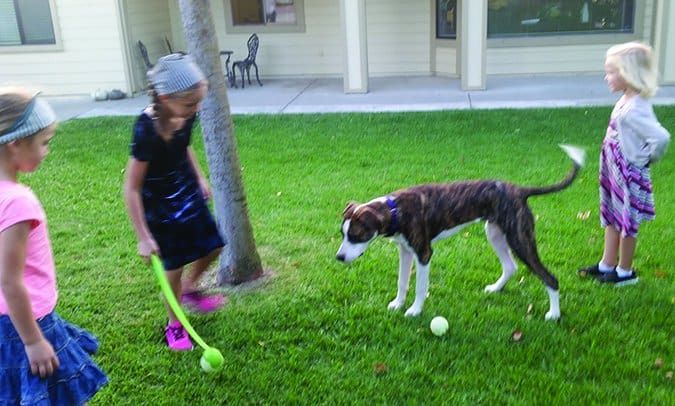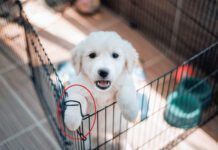I used to pride myself on the fact that I had never been a so-called “foster failure.” As most of you probably know, that’s what they call you if you take on a foster dog or puppy and, though you had no intention of doing so when you accepted the fostering commitment, you decided to keep the dog for your very own. I took pride in not keeping any of my foster dogs, because the more you keep, inevitably, the fewer you will be likely to foster in the future. After all, not very many of us have unlimited resources of time and money to spend on our dogs.
But a little bit more than year ago, I failed; I fell hard for a pudgy pit-mix puppy I had been fostering, along with eight of his brothers and sisters. Why? Why did I fall for that puppy? For that matter, why would I fall for any puppy? After all, as cute as they are, no one knows as well as someone who fosters a lot how much work puppies and adolescent dogs can be! And prior to taking on that litter, I had absolutely no desire for another dog. At the time, I was already fostering an adolescent American Black and Tan Coonhound named Maebe, and she was annoying Otto, my “heart dog,” to no end. What on earth, I’ve been asking myself for the past year, made me decide to keep this puppy? And what have been the costs to our formerly copacetic canine/human family?

A Puppy Who Is Focused and Connected
In the interest of full disclosure, I usually do develop a preference for one puppy in each litter I foster – but I have never, ever, considered keeping one until this particular favorite pup came along. I noticed early on that the big brindle male pup had extraordinary powers of concentration at the precocious age of four weeks, and boy, do I like that in a puppy or adult dog. I teach all of my foster pups that I will pop treats into their mouths if they sit and pay attention to me, and this pup was the first to retain and actively use this information. When I would work with the group, the big brindle male was always the first to sit down and fix his eyes on my face. The pups with shorter attention spans (and/or less interest in food) would continue to play, sometimes even jumping on the big pup in an effort to get him to return to their games, but the big guy would literally shrug them off, never taking his eyes off of mine. It was as if he were saying, “Get lost, kids; I’m working here!”
He was also the first pup to learn how to follow me down the seven stairs off the back porch into the backyard, and the first to follow me back up the stairs, too. I found that almost every time I tripped over a puppy, it was because that one big guy was on or right next to my foot.
Surgery day arrived, when I took the pups back to the shelter to get altered and then go up for adoption. I kissed their puppy heads, as I always do on the day they “graduate” from foster care, and I said a special goodbye to the brindle boy. Unlike always, I started crying when I said goodbye to that pup, and the shelter workers laughed – kindly – as I walked out of the shelter with tears running down my face, unable to talk. It’s hard, sending those sweet little faces off to uncertain futures! But in most cases, I cheer up over the course of the day, and by day’s end, I’m super happy to be done with puppy pee and poop for a while, and eager to see the puppies’ adoption photos, taken with their new owners, popping up on the shelter’s Facebook page.
In this particular case, however, I stayed weepy all day – so much so that I developed a really bad headache. That’s why I was prone on the sofa, a pillow over my head, when the shelter’s vet tech called me to say that they hadn’t been able to finish all the surgeries for the day, and would I want to take the two males home for another week of fostering? My pillow flew through the air as I flew out the door to go pick up the brindle boy and his only brother, a gorgeous gray pup with pretty pale blue eyes.
When Other Puppies Pale in Comparison

Every time I laid eyes on that handsome gray pup I’d think, “He’s going to go fast! Someone is going to LOVE that puppy.” But that someone was not me; I still was just oddly crazy about the chunky brindle boy. He had the most fantastic eye contact, and even when I wasn’t looking at him, I would often discover that he was looking at me.
One day I watched a video online about “platform training,” wherein a trainer used a little box to help a dog “station” – to help him understand exactly where he should sit, down, or stand (as cued). Just for fun, I got some treats, and started teaching Maebe, my foster hound, to step up onto a little plastic step stool; I thought I might try the platform training with her. The two male puppies were in my office, playing on a dog bed, but when the brindle pup smelled treats, as usual, he came over and joined in the training session; as usual the gray pup did not volunteer. I worked with the hound and the pudgy pup for about five minutes, rewarding them for putting their front paws on the stool, and then I went back to work on my computer.
About an hour later, I rolled my chair back, stretching, and glanced around to see where all my canine charges were. Otto was asleep on a couch in the living room. Maebe was asleep on the couch in my office. The gray pup was asleep on the dog bed next to my desk. And the brindle pup? He was sitting on that little plastic step stool in the next room, looking at me through the doorway. Had he been sitting there for the past hour? I have no way of knowing, but he was just so dogged, he very well might have been.
I didn’t make the decision to keep the puppy that day, but, looking back, that was the moment that clinched it. When I took both male puppies back to the shelter the following week for their surgeries, I filled out an adoption form.
New Puppy Duties
My husband is in charge of naming our pets, and usually I leave the task completely in his hands. This time, though, I asked him to consider one criterion: I wanted him to pick an especially friendly name. Given that the pup was clearly going to have a “bully breed” look, I wanted a name that would counter any tough-guy baggage that can come with those looks; despite the promise of his size, I didn’t want a Thor or Bruiser.
My husband proposed the name Woody, after the beautiful wood-grain look of the puppy’s coat, and I loved it. It evoked the sweet cowboy in the “Toy Story” movies – “I’d like to join your posse, boys, but first I’m gonna sing a little song!”
Of course, it’s just a coincidence, but it’s a funny/sometimes not funny coincidence that Woody has developed a strong predilection for chewing things made of wood, such as chair legs, parts of our deck, rosebushes, apple trees, dog houses, and more. If it’s wooden, it’s been given a speculative chew. I’ve gone through quarts of Bitter Apple (a chewing-deterrent spray for dogs that tastes terrible), which actually does deter the teething adolescent, but usually just makes him go search for something that hasn’t been sprayed yet.
Even with the usual amount of puppy-wrought destruction, though, Woody somehow hasn’t managed to aggravate my husband, who usually likes dogs only provisionally – when they are quiet and well behaved. Oddly enough, Brian likes Woody even though he is not always well-behaved; he’s so full of athletic energy, enthusiasm, and curiosity, he’s always bounding around, into, and through us. But it’s hard to hold a grudge against him, even when you get a fat lip from getting hit by his head when he does a random hop up (a kissing bandit sort of move), because he’s turned into such a genial, goofy guy.
Woody’s “happy dog” demeanor didn’t just happen, however; I’ve been cultivating it like a prize rosebush.
Raising a Pit-Mix Puppy
Again, given the fact that it was clear that Woody was going to grow up into a big, powerful dog with one of those blocky, bully-breed heads, I felt like it was incumbent on me – as it should be on the owners of all similarly big, strong dogs – to take extraordinary measures to make sure that he is well socialized, well trained, and well managed. In July 2016, WDJ published “The 10 Most Important Things to Teach Your Puppy,” by Pat Miller – check those out for a complete puppy checklist. The following are all the measures I’ve personally and deliberately taken over the past year to meet my goal of building a solid canine citizen:
1. Immersed Woody in every puppy fostering opportunity I’ve had over the past year. He’s played “big brother” to four other large litters of puppies that I’ve fostered since he was adopted. This has given him extraordinary social skill, especially with smaller, more fragile dogs. He also finessed his way into the heart of the protective Great Dane mother who stayed with us for months with her litter of 11 puppies. She didn’t like him near the puppies at first, but by the time she got adopted, not only had he earned her approval for puppy-playmate privileges, she liked to wrestle and play with him, too.
2. Enrolled him in puppy kindergarten classes with a positive-reinforcement based trainer, and took him to additional “puppy socials” at the same well-managed facility.
3. Exposed Woody to many other types of animals in controlled settings, taking special care to prevent him from having any opportunity to practice an unwanted behavior even once. For example, I made sure that the first times he saw poultry and livestock, he was on leash, so he never had a chance to see an animal run away from him “by accident.”
4. I sought out opportunities for Woody to meet and hang out with humans of all kinds, and especially babies and children. This is no small feat when you have a dog who looks scary to some people! But I made sure that every interaction he’s had with kids has been enormously rewarding, full of extra-special treats and toys. And it’s worked so far! When he sees a kid, he wriggles with joy and anticipation.

5. I’ve taken Woody into every store in my area that welcomes dogs, and every sort of vehicle I have access to. And I always – always – have treats on hand, so I can reinforce his good behavior, and do a little counter-conditioning if I see signs that he’s getting at all nervous.
The Puppy Adolescent Fear Period
All of this super-socializing might seen excessive to some, but something happened to Woody at about seven months of age that prompted me to put my socializing efforts into overdrive, rather than cruise control. One day, out of the blue, with no precipitating event that I could recall, Woody started raising his hackles and emitting a soft growl when he saw certain people or other dogs. It wasn’t every time, just sometimes, but there was no pattern to it that I could discern. Overnight, he went from happy to meet everyone, to happy to meet most people, and scared to meet some.
I’ve edited enough articles about canine fear-based aggression to know that what Woody was expressing was anxiety, and that the best way to ease a dog’s anxiety was to:
– Increase the distance between the dog and whatever is scaring him, until he can observe the scary thing or person calmly; and
– Counter-condition generously, by feeding him tons of super-delicious treats, in an effort to make him feel better about the situation, without pressuring him for any particular behavior.
I also asked every dog trainer I know personally (and every dog training contributor to WDJ!) about this behavior, and they all said the same thing: “It’s the adolescent fear period. Not all dogs go through it, but any dog can. Keep doing what you are doing.”
We’ve been doing that, and it’s working. Woody has mostly come out the other side of this tunnel of fear, and rarely growls or raises his hackles upon seeing people he doesn’t recognize. I’ll tell you more about our continuing efforts to work through this unexpected challenge in a future issue. If you are seeking more info on puppy socialization now, read Denise Flaim’s article, “Properly Socializing Your Puppy“.
Nancy Kerns is editor of WDJ.







I just have to say I saw one article and had to find out more about this pupper because he looks so much like my pupper. The red brindle and facial features are so similar. My friends dog had a litter of puppies and for some reason i got very attached to my boy that i begged my father for him and even went as far as to spend hours making yarn vodoo dolls and sold them at our farmers market(back when those were popular). I cleaned poop out of a chicken coop and a back porch for an older lady. Anything to get the money to buy him. Little did I know my father had purchased him and all my money went to getting his collar and such. To this day (he is 5years old now) he is my inspiration to become a dog trainer and i am on my way as soon as tax season comes around i should have the money for collage. Very excited and im glad to see someone else loves there brindle baby.